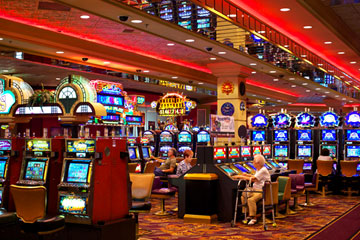
Las Vegas local, Eleanor Kochanski, center right, plays one cent machines in the Penny Lane area of The Orleans casino, in Las Vegas on Wednesday, June 26, 2013.
(3 of 6)
The financial meltdown caught Vegas at a particularly vulnerable time. In 2007 and 2008, while industries from autos to real estate to airlines were shedding capacity, this town was doubling down. More than $15 billion of new properties opened as the bottom dropped out, capping an investment bubble in a city that increased its room count from 133,000 to 150,000. You didn't need to be an economist to see trouble ahead, but the CEO of Caesars, Gary Loveman, happens to be one. He left a professorship at Harvard to render unto Caesars. "The local market experienced an astonishing supply accretion," he told Time. "The fact that we held on is absolutely stunning. We've had to work really hard." If not for their prudent investments in Macau--which produced $38 billion in gambling revenue last year, dwarfing the take in Vegas--companies such as Wynn and the Las Vegas Sands would be in serious difficulty.
Across the country, gambling is reaching a saturation point as states that were late to the party, including New York, Kansas, Maryland and Maine, licensed more facilities in an effort to increase tax revenue. More than 70% of U.S. gambling revenue is generated outside Nevada. Ohio became the 23rd state to join the party, opening four casinos since 2012. Massachusetts is next. Nationally, gambling revenue rose 4.8% last year to $37.34 billion, according to the American Gaming Association--still below 2006 levels. But seven states suffered revenue decreases as play was distributed among more casinos.
Although Las Vegas is a shameless city, it got caught with its paradigm pants down. The segment of tourist dollars spent on gambling, now less than 50% of the total, has been declining for years as the town continues to open more celebrity-chef restaurants, Cirque du Soleil shows, high-rise amusement rides and nightclubs. Diversification has long been part of the city's strategic plan, and that has helped Las Vegas retain its status as one of the country's top tourist and meeting destinations.
The newest entertainment twist now is day clubs, like the Bare Pool Lounge at the Mirage ("where women are free to frolic topless") or Liquid at Aria, where celebrity DJs like E-Rock gather half-naked 20-somethings at poolside parties to swing the afternoon away until the night shift commences at such ultra-hot clubs as Tryst at the Wynn that buzz until the next pool opens. This younger crowd views gambling more as a sporting diversion, not something to take seriously or do for very long.
There's no way, though, that millennials swilling overpriced designer vodka can match the profit of a $25 blackjack table that hands out free booze. A 5,000-room casino hotel that runs 24/7 has high operating costs, and it's the gambling action that has covered them. The magic of a casino hotel is that once the costs are covered, profit mounts prodigiously--in accounting jargon, this is a business with very high operating leverage.
